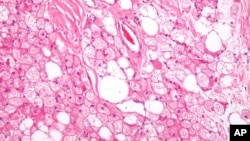Not all fat is bad. A new study has found that fat cells that lie beneath the skin’s surface may protect against bacterial infections.
U.S. researchers say dermal fat cells, known as adipocytes, produce peptides or proteins that shield against invading bacteria.
Experts explain adipocytes provide immediate defense against bacteria by producing antimicrobials, giving immune system white cells time to reach a wound site.
A common skin infection is caused by Staphylococcus aureus.
Researchers at the University of California School of Medicine San Diego report that in mice with a skin infection, the number of fat cells increased both in number and size.
Within hours of the infection, the cells produced high levels of an antimicrobial peptide called CAMP.
Investigators report their findings in the journal Science.
Scientists say if people have too little CAMP, they experience frequent Staph and viral infections. But too much of the peptide can drive autoimmune diseases such as lupus and psoriasis, which attack the body’s own tissue.
The finding, say researchers, could lead to the development of drugs to boost the immune response of some people, including diabetics, who are prone to developing skin infections.











